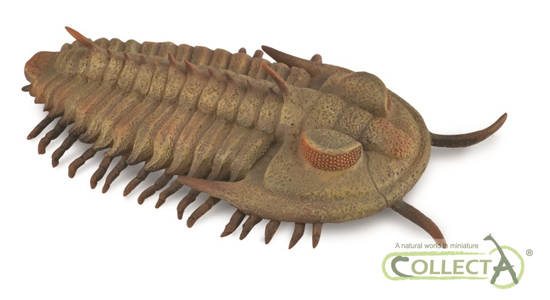Trilobite Reproduction Puzzle Solved by New Research
Trilobite Eggs Found in Ordovican Fossil
Trilobites are some of the most recognisable fossils to be found in Palaeozoic strata. However, despite there being tens of thousands of exceptionally preserved specimens, little is known about how trilobites bred. Trilobite reproduction has remained a bit of a mystery. A team of scientists from Western Illinois University in collaboration with colleagues from Vanderbilt University (Nashville, Tennessee), writing in the academic journal “Geology” have published a paper on a remarkable fossil find. They report finding the first evidence of trilobite eggs preserved within a fossil specimen.
A Trilobite Fossil
The Trilobita
Trilobites are an extinct, geographically widespread and abundant group of Palaeozoic arthropods that evolved in the Cambrian and survived until the Permian mass extinction event some 252 million years ago. Trilobites have a distinctive threefold longitudinal division of the body and a tough exoskeleton. At least ten Orders of Trilobita have been assigned and although most trilobites were small, the largest specimens grew to up to a metre in length.
All trilobites lived in marine environments and they evolved to occupy a number of ecological niches from active, predatory nektonic animals to epifaunal forms. In order to grow, these animals had to moult and shed their exoskeleton. The cast exoskeleton readily fossilised and as a result, huge numbers of trilobite fossil material is present.
Triarthrus eatoni
An analysis of an exceptionally well-preserved specimen of the Late Ordovican trilobite (Triarthrus eatoni) from the Lorraine Group found in the United States has revealed the presence of nine tiny eggs, clustered together in an area located underneath the head shield (the genal area of the cephalon). Other specimens also show evidence of eggs within the fossilised form.
Digital Images from the Computerised Tomography Showing the Tiny Eggs
Picture credit: Geological Society of America
The image above shows close up views of the cephalon and the upper portion of the trunk. Picture K represents a dorsal view (view from the top), picture L (ventral view), viewed from underneath and picture M is a left ventral view. The egg cluster, represented by the tiny white dots can be clearly seen.
Spherical and Elliptical Eggs
Like many fossil trilobite specimens from the Lorraine Group, the complete exoskeleton has been replaced with pyrite. The eggs are described as being spherical to elliptical in shape, although the fossilisation process could have distorted the material. Each egg is approximately 200 μm in size, that’s around half the width of a human hair. The eggs are only visible ventrally with no dorsal brood pouch or recognised sexual dimorphism.
Triathrus eatoni (Ordovician Whetstone Gulf Formation) Reveals Eggs
Picture credit: Geological Society of America
The picture above show a pyritised specimen of T. eatoni, part of the collection of the Yale Peabody Museum showing nine eggs (picture A is ventral view). Picture B shows a second specimen with four eggs preserved in the right genal area. The image (picture C) is a close up of the eggs in specimen B, whilst D is a closer view of the eggs preserved in specimen A.
Highly magnified (scanning electron microscopy), views of an egg cluster (E) with a closer view of a single egg (F). Picture G shows the egg surface under high magnification.
A close up of a single limb from specimen A is shown in picture H, whilst images I and J show pyritised elements of the body fossil.
Trilobtie Reproduction Strategy Similar to Modern Horseshoe Crabs
The location of the eggs is consistent with where extant female horseshoe crabs release their unfertilised eggs from the ovarian network within their head. Trilobites probably released their gametes (eggs and sperm) through a genital pore of as-yet unknown location (likely near the posterior boundary of the head). If the T. eatoni reproductive biology is representative of other trilobites, they spawned with external fertilisation, possibly the ancestral mode of reproduction for early members of the Arthropoda.
An Trilobite Model
To view the CollectA model range: CollectA Age of Dinosaurs Popular Models and Figures.
As pyritisation preferentially preserves the external rather than internal features of fossils, it is suggested that there is likely a bias in the fossil record toward the preservation of arthropods that brood eggs externally, animals with an exoskeleton that brood their eggs internally are unlikely to preserve any evidence of their mode of reproduction.
The scientific paper: “Pyritised in situ Trilobite Eggs from the Ordovician of New York (Lorraine Group): Implications for Trilobite Reproductive Biology” published in Geology.
Visit the Everything Dinosaur website: Everything Dinosaur.





